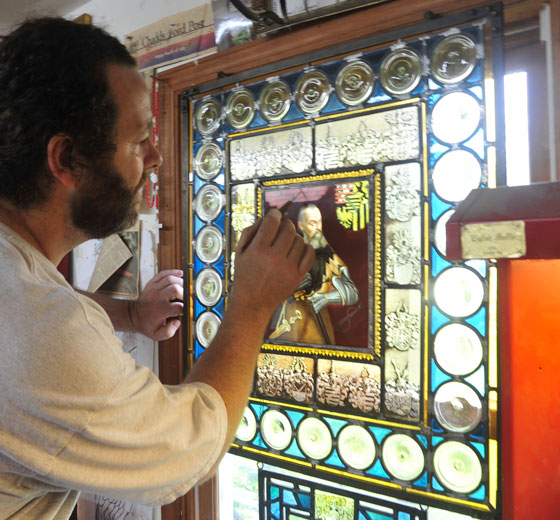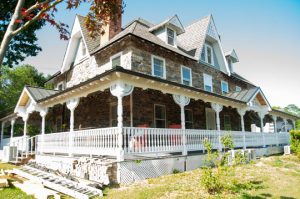Artist Lucas Cranach (1472-1553)
became the court painter to the Saxons in 1505. In 1537 he painted a portrait
of Duke Henry of Saxony on lime wood. Someone, perhaps Cranach himself or his
son, used that lime wood painting as the model for a portrait on glass.
The original wood painting was
lost, stolen or destroyed during WW II. It was in a museum in Dresden, a city
the allies firebombed. The glass portrait, however, survived. It was already in
the United States.
That glass piece, now owned by
the Robinson family of Havertown, was broken and in need of repair. Reva Robinson
brought it to Rob Horan of Pennsbury Township.
Horan is the artist behind
Antiquity Glass, a stained glass business that Horan and his wife have operated
in the Chadds Ford area for many years.
While it wasn’t the first time
he’s had to restore a centuries-old piece of art, Horan said he still becomes
reflective when facing such a project. Many things go through his mind.
“I think about the technology
500 years ago, what they had to work with to make something this awesome.
That’s where I’m in awe. You didn’t go to the local stained glass store and say
‘Give me some silver stain and I need some paint to match this color.’ Theses
guys had to make all this stuff,” Rob Horan said.
What he finds so interesting is
that those were the days of alchemy that preceded modern chemistry.
He also reflects on his own
skills and takes his time approaching the work.
Horan tells himself, “First, be
super careful. Treat it like a treasure. I always have to tell myself to slow
down… a snail’s pace. Breaking it down is very nerve wracking. You can break
pieces very easily.”
He had the portrait in his
workshop for three months and just let it sit there while he worked on two
other pieces the owner brought in. He would look at it, observing, taking in
whatever he could glean from the image.
“I had it on a light table and
it was lit every day before I was even working on it,” Horan said. “I’d just
look at this thing. It’s like a teacher, like having a teacher in the studio
saying, ‘look at how this is done.’…I saved this piece for last. I knew it was
special. It had Renaissance painter written all over it.”
Then the actual work—the
repainting— finally began. What Horan did was put new glass on top of the old
one, and paint over the missing and broken areas.
The key thing about all
restoration, he said, is that the new work has to be reversible. The original
can’t be touched. Horan did his restoration by painting on a separate, thinner
piece of 1/8th-inch window glass that was placed over the original.
That work covered the chips
and the missing pieces.
“You never, ever, ever paint on
an ancient piece like this,“ he said. “All your painting and restoration is
done on a piece of glass and then it’s plated over top of the original.”
With all the work, though, some
cracks still show. He said that an attempt to make them disappear would require
so much layering that it would take away from the original painting.
“That wouldn’t be a good idea,”
said Horan. “This was a masterpiece painting and you don’t want to hide that.
So you just want to subdue the cracks, make them less visible.”
There was some irony in the
project for Horan. He’s restored other pieces from the same era, one that, he
said, matched the quality of the duke’s portrait. That particular piece was a
portrait of Martin Luther.
In researching Cranach, Horan
learned that the artist was a close friend of Luther and did many portraits of
the religious leader. Horan is wondering if that earlier piece was also a
Cranach.
Horan isn’t 100 percent certain
that it was Lucas Cranach who did the glass portrait of the duke but, based on
a photo of the original wood painting, he thinks it was because the figure,
coat of arms and the text on the glass are exactly the same as what shows in a
photo of the wood painting.
The original lime wood painting
had the inventory number 1915 while in the Gemäldegalerie in Dresden, Germany.
It is believed destroyed or lost sometime between Feb. 13 and 14 during the
allied bombing raids or in the subsequent fires.
About Rich Schwartzman
Rich Schwartzman has been reporting on events in the greater Chadds Ford area since September 2001 when he became the founding editor of The Chadds Ford Post. In April 2009 he became managing editor of ChaddsFordLive. He is also an award-winning photographer.



Comments